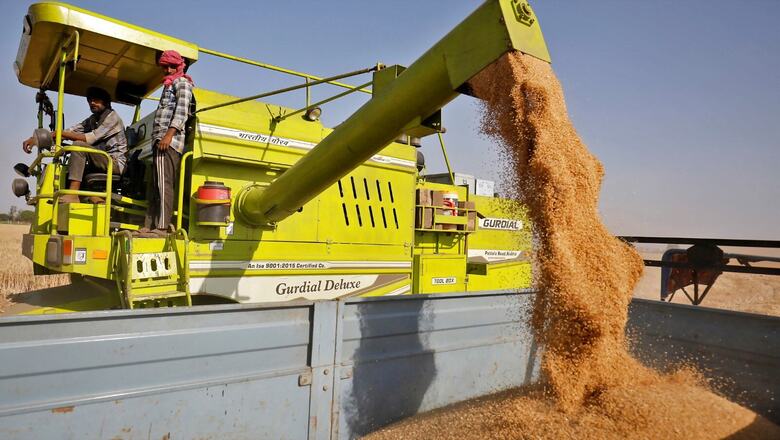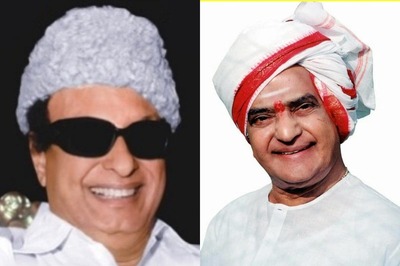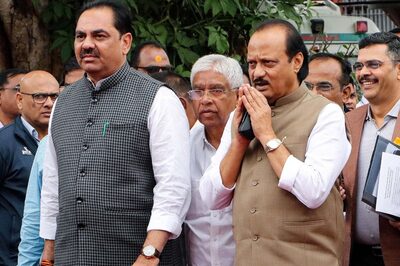
views
In Infra Vaani, noted infra expert Akhileshwar Sahay dissects infrastructural challenges of Indian cities and offers solutions. In a three-part series this week, he looks at India@75. Part 2 looks at food, waste, air pollution, power, internet and mobile services.
Four critical necessities for humanity to survive are clean water, food, clean air and habitat. In part one, the column touched upon water and habitat. I begin this piece with food, what we inherited at Independence, where we have reached and what we need to do in the Amrit Kaal.
FROM SHIP TO MOUTH TO ABUNDANCE, BUT STILL HUNGRY
India got Independence in the backdrop of the famine of 1942-43, in which more than two million people had perished. Although the country’s population was barely 340 million against today’s 1.412 billion, critical food scarcity was the biggest problem the nation builders faced.
Unsurprisingly then, feeding more than 30 people at a wedding was proscribed and Prime Minister Lal Bahadur Shastri was constrained to issue an appeal that every Indian should fast for one day a week to enable the government to balance the food budget.
Why was the country in such dire straits?
The key reasons were subsistence farming, only 10% irrigation, frequent monsoon failures and famines, poor yield per acre and the pressure to grow only commercial crops for the British Raj to export.
Consequently, the food security at Independence was a shambles. As a wise man said, Indians “had a lot on their plate but nothing in their belly”.
The situation was so precarious that amid the spate of unending food emergencies and a critically deficient food supply chain, newly independent India became a hapless ‘ship-to-mouth’ economy with three-five ships full of grains and food supplies landing daily at the Indian ports from America, and the food being distributed and consumed immediately. It was such a scary situation that the UN’s Food and Agricultural Organization, in a 1961 report, predicted that “India’s population would outstrip its food production in five years”.
Circa 2022.
India is a major food and milk exporting nation.
The combination of PM Shastri, American scientist Borlaug, our own M S Swaminathan, the Green Revolution and high yields of rice and wheat changed the nation’s fortune on food security. The ‘one-man institution’, Verghese Kurien, converted India from a ‘net importer of dairy products’ to a behemoth that produced 23% of the global diary products and became the biggest exporter.
How the above happened is a subject matter of many books.
But the net impact is that in 2022, we are living in a transformed India.
In FY22, the country’s food grain production comprising rice, wheat, coarse grains and pulses was a record 315.7 million tonnes, led by record production of rice 130.3 million tonnes and pulses at 27.7 million tonnes. This happened despite the wheat production at its lowest in three years, and 2.5% lower than 109.6 million tonnes produced in the previous FY 2020-21. Oilseeds production, too, hit a record of 37.7 million tonnes.
For FY23, the government has set the food grain production target at record 328 million tonnes, which is 3.8% higher than FY22.
Also, the country has an unprecedented 120 million tonnes of food grain in its godowns.
India@75 has much to celebrate.
But with a caveat, hunger remains a problem.
As per the recent State of Food Security and Nutrition in the World (SOFI) report, released jointly by five UN organisations, the prevalence of moderate to severe food insecurity in India increased by 6.8 percentage points in 2018-20 and in absolute terms, persons in the grip of moderate to severe food insecurity went up by 9.7 crore since the outbreak of Covid.
The nation with the largest stock of grain in the world is also home to a quarter of the world’s food-insecure population.
While we may contest the accuracy of the SOFI report, the task for India in the Amrit Kaal is cut out — much before India@100, not even one Indian should sleep hungry. We already have the enabling legislation, Food Security Act, 2013, and we have already made an audacious beginning with the ‘One Nation One Ration Card’ to provide heavily subsidised food to 80 crore Indians.
THE TRASH BOMB
India, the third-largest solid-waste producer after China and USA, faces humongous solid waste management challenge across the value chain — generation, collection, transportation, treatment, and disposal.
The complexity of solid waste management problem in the country is best explained by MIT USA doctorate, the late Indian economist Isher Judge Ahluwalia for whom, best municipal solid waste management practices were “her passion”.
I begin with a few of her comments: “One, it is impossible to assess the right quantum of municipal solid waste (MSW) generated in Indian cities and towns. Two, rising incomes, rapidly growing, but unplanned urbanisation and changing lifestyles are leading to increased volumes and changing composition of MSW. Three, managing continuous flow of daily growing MSW on daily basis is a monumental challenge. Four, bigger crisis is the legacy of neglect which has resulted in garbage hills being built up at dumpsites that were originally allocated for developing landfills for safe disposal of only the residual waste.”
First, what is the magnitude of the problem?
The biggest problem is opaqueness of the data regarding how much waste the country generates. Rural or urban, there is no effective system to know the quantum of waste generated daily. And whatever data-points exist, estimations and projections of solid waste vary wildly from agency to agency.
No current dataset regarding solid waste generated by rural India is available. The latest I could lay my hands on is 2012 Water and Sanitation Program (WSP) and Government of India ‘Handbook on Scaling up Solid and Liquid Waste Management in Rural Areas’, which emphasized that the quantity of waste generated is increasing fast in rural areas as a result of increased population, consumerism, and commercial activities. According to the report estimates, in 2008, rural India generated three to four lakh tonnes of solid waste daily.
One can only guess about the present generation of rural solid waste.
There are a few estimates available of urban MSW. In 2014, a Planning Commission taskforce projected India would generate 2,76,342 tonnes per day (TPD) of waste by 2021; 4,50,132 TPD by 2031 and 11,95,000 TPD by 2050.
The more proximate data from the Central Pollution Control Board (CPCB) says that in 2017, MSW generation had already exceeded 1,50,000 daily. Contrarily, as per Swachata Sandesh Newsletter by the MoHUA, as of January 2020, 147,613 tonnes of solid waste are generated per day, from 84,475 wards.
And the truth is scarier because as per the projection of the World Bank, by 2025, India would generate more than 3,77,000 tonnes MSW daily.
Instructively, estimation of MSW is of questionable integrity as it excludes inefficiency in collection, littering on streets and roads and MSW dumped into rivers, other waterbodies, lakes, nullahs, storm-water drains and sewage lines.
Where does the waste go?
One, in rural India, solid waste gets dumped unsegregated inside or outside villages as availability of land so far is not a critical problem. However, this solution will soon run its course.
Two, with low collection efficiency, an increasingly larger chunk of urban MSW gets dumped on streets, roads, rivers, lakes and drains and sewerage systems.
Three, Solid Waste Management Rules (2016) mandate the segregation of waste by households into three categories: biodegradable, non-biodegradable, and hazardous waste. However, segregation just does not happen, unsegregated and untreated waste gets dumped in dump-yards, some within city limits and some outside. These dump yards have turned into toxic mounds, with severe soil, water, and air pollution and severe health implications to those who stay in the vicinity. In bigger cities, these dump-yards have already turned into giant killers. Most landfills have reached the saturation point and are overflowing. With non-availability of an alternate site, there is no space to accommodate fresh garbage waste.
What is the solution?
Left to its own fate, solid waste management will soon assume monstrous proportion. Business as usual will turn cities, towns and even villages into one big dump yard.
There are effective solutions.
I list a few:
One, the country has twin problems — legacy waste and waste generated daily. It is time to accept that our seriously flawed waste management system is unsustainable.
Two, the only sustainable solution is a nation-wide participative movement to reduce the waste generation to absolute minimum. South Korea has done it. All other solutions have financial, environmental and health related cost.
Three, the sooner the country embraces ‘circular economy principle’ of ‘reduce-recycle-reuse’, the better it is. Apart from focus of reduction in waste generated, there is a need to follow maximum waste recovery through composting, recycling, reuse, and other available measures.
Four, once MSW is generated, the only solution is proper segregation at source, putting it to recycling and resource recovery and only the residual waste has to go to the scientific landfill. This is no rocket science.
Five, transporting waste to landfills is a costly affair. The country has to find decentralised solution of composting, bio-methanation, recycling, pyrolysis, waste-to-wealth, or waste-to-energy.
Six, it is time to make waste generators pay and those who do not follow the rules pay heavily.
Seven, MSW is a community problem, and no top-down solution will work. It is time for behavioural change and that requires involvement of people.
There are success stories worth emulating within the country. Kerala, Chhattisgarh, Ahmedabad, Chandigarh and Manali ward in Chennai give hope. Globally, there are learnings from South Korea, Finland, and Austria.
It is time to create Indian next practices lest the nation will drown under the debris of its trash.
AIR OF DEATH-THE SLOW KILLER
Water pollution is not the only killer. Air pollution (both indoor and outdoor) has turned the slow and silent giant killer.
Why air pollution matters?
The CPCB, in its report for air pollution for 2019, says that on average, a person inhales about 14,000 litres of air daily. Poor air quality affects the quality of life now and for future generations by affecting health, environment, economy and city’s liveability.
If this is the case, safe water and clean air are the two most critical infrastructure for a liveable life.
How polluted is India’s air and what are the consequences?
Air pollution today is a serious threat to human life, country environment and its economy. It also has serious consequences for our next generation.
A Lancet study (2020) had following findings:
One, in 2019, air pollution was responsible for 1.7 million premature Indian deaths i.e., 18% of the total deaths of the year.
Two, both ambient particulate matter pollution and household air pollution contributed significantly to these deaths.
Three, economic losses from premature deaths and morbidity were US$ 37 billion annually or 1.36% of India’s GDP.
In 2018, one WHO report based on monitoring 4,300 world cities for air pollution in terms of PM 2.5 levels found that 14 of the 15 worst polluted cities were in India. Kanpur was the global worst.
Other studies indicate that air pollution has turned into the second largest risk factor for ill-health, only behind malnutrition. Since 1990, death rates from ambient air pollution in India have more than doubled.
Also, a recent report by the ‘Health Effects Institute’ says if no urgent amends happen to reverse the ongoing regular crises, deaths from air pollution in India will rise from “1.1 million in 2015 to 3.6 million deaths annually by 2050”.
And the crisis just worsened. As per AQ Air 2022 report, Delhi, for the fourth consecutive year, is adjudged the world’s most polluted capital. Also, 35 Indian cities are in top 50 globally most polluted cities and 64 in world worst 100.
Add to this crisis, there’s a more troubling data set:
One, 76% Indians live in places that do not meet national air quality standards and 99% breathe air that is above the WHO’s defined safety limit
Two, one in every eight deaths is directly attributable to air pollution, elderly, women, poor and children suffer most.
Three, air pollution in cities, towns and villages is worsening fast. But more than 60% Indians live in areas where extent of air pollution is unknown because there is has no monitoring station. By CPCB’s admission in 2020, it is able to monitor air pollution through only 804 ambient air quality monitoring stations covering 344 cities/towns.
Air pollution in rest of India is not even monitored.
Why are we in this situation?
One, air pollution is a complex cross-sectional problem with varied emission sources contributing to the chaos.
Two, India’s air pollution is partly God-ordained. The geographical and meteorological factors of the country make Indians vulnerable to the lethal and silent air pollution.
Three, air pollution is also by-product of faster GDP growth and our rising prosperity.
Four, in urban areas, worst pollutants are particulate matters PM2.5 and PM10, whose emission levels are worsening with key contributor’s transport, emission from industries, construction activities and road dust.
Five, in rural areas, household combustion is the key source.
Seven, other pollutants nitrogen oxides, sulphur, carbon dioxide and carbon monoxide, too, are fast becoming areas of concern for the country.
What are the consequences of air pollution?
The consequences of Air Pollution are severe and lifelong – premature mortality of children, reduced lung function, asthma, COPD, and diseases impacting heart, kidney, and liver are a few direct impacts.
What is the government doing and what are the solutions?
One, in 1980, India did not measure pollution. It had no monitoring station. Even in 1984, as per CPCB dataset, the country had just seven monitoring stations, which increased to 260 in 1992, 523 in 2011, 680 in 2016 and 804 in 2019.
Also, monitoring stations existed only in 300-odd cities and are often dysfunctional.
The monitoring stations ratio in India is poor 0.14 monitors per million people, well below China (1.24), US (3.4), and Brazil (1.8).
The Indian paradigm: ‘Best way to combat air pollution is blissful ignorance and denial of the problem’
Two, denial of the problem, including its severity thereof, is the mantra so far. Findings of global reports are routinely debunked, citing bias, unconnected to Indian conditions and unreliable causality link between air pollution, health, and mortality risk.
Three, tentative first steps were taken in 1982 by establishing the National Air Quality Standards that were last revised in 2009. The standards led to starting of the National Air Quality Monitoring Programme (NAMP) to determine the status of ambient air quality and monitor compliance with prescribed standards. However, its impact has been limited due to paucity of monitoring stations
Four, there is total inaction at state level. Air pollution is local in origin (cities, towns, and villages) but global in externalities. Air pollution has to be reduced where it occurs with the active co-option of citizens.
Five, first directionally correct waking up has happened at the central government level. In 2019, it began the National Clean Air Programme (NCAP). The plan mandates 132 cities with high pollution levels to devise city-specific action plans with the overall aim of reducing PM2.5 and PM10 emissions by 20-30% by 2024 compared to the 2017 levels.
Finally, pollution is negative externality. Someone pollutes and someone else faces the music. The country has not yet warmed up to the need of making polluters pay the real cost of polluting.
What is the solution?
Clearly, India needs futuristic visionary strategic planning and evidence-based solutions and decentralized implementation to hit pollution where it originates.
Developed countries have cleaned their pollution and now China, the poster boy of air pollution, in the first decade of the century is also doing it. Today, no Chinese city is in the worst 15, and just a couple in the worst 20.
Beijing has exited the 20 worst in terms of air pollution.
Solutions are no rocket science. Evidence-based solutions exist. The GOI has taken few measures, but what is needed it scaling up, mainstreaming, and waking up of states. India has to move totally away from fossil fuel if net zero by 2070 has to become reality.
AWAY FROM DARKNESS
The Indian power sector metamorphosis is a singular success story. The country had its tryst with destiny in the darkness of the midnight. The total power installed capacity was 1,362 MW and per-capita consumption was nano 16.3 kWh.
At Independence, a few households in selected cities had electricity connection and no village was electrified.
Back to 2022. India is third largest electricity producer globally. And the transformation has been across the value chain –generation, transmission and distribution.
I begin with generation, arguably the biggest success story. Power generating capacity has taken a quantum jump to 403,761 MW at the end of June 2022 and with per-capita consumption above 1,208 kWh.
It has been a learning and rewarding journey for the country which from severe electricity deficit nation at Independence has charged all the way to power surplus nation with total installed capacity at 3,70,106 GWh, with almost all homes including nearly 100% villages out of darkness.
The country has added new electricity connections for 50 million citizens each year over the past decade.
Also, generation has been a success story of private investment. Of the 4,03,760 MW installed capacity, private sector accounts for 1,99,785 MW i.e., 49.5%, while the centre’s share is 99,005 MW (24.6%) and states’ 1,04,969 MW (26%).
Power sector has also moved away from fossil fuel. The share of renewable energy to the total basket is now, 40% with relative combined share of solar and wind at 28% and hydroelectric at 11%.
India’s power demand is growing fast.
As per the Central Electricity Authority’s Optimum Energy Mix report, the demand will hit 817 GW in 2029-30. Of this, 522 GW is estimated to come from renewable sources, which includes wind energy’s 140 GW and solar 280 GW.
The country has already met 2022 target of 175GW renewable capacity.
With the share of solar and wind growing fast, the country plans to raise the share of renewables to 50% by 2030, installing 500 gigawatts of renewable energy capacity, reducing the emissions intensity of its economy by 45%, and reducing a billion tonnes of CO2 on pathway to Net Zero emission by 2070.
Along with the quantum jump in generation, the country has also taken a giant leap in transmission.
Power transferability and grid security are critical for the sector. The country got a rude shock when 22 states faced a total blackout for two days on July 30-31, 2012 due to transmission grid failure. Today, inter-state transmission grid is the strongest link in electricity supply chain. One-third of the power generated can now be transferred across state boundaries.
India’s electricity grid is one of the largest synchronous grids in the world. The total transmission line length (at the 220 kV level and above) is 453,141 ckt; the total AC substation capacity 1,055 GVA and HVDC substation capacity 33,500 MW.
Between 2015-16 and 2020-21, the line length grew at compound annual growth rate of 5.3%, while AC and HVDC substation capacities at 9% and 14.5%.
While generation and transmission sector are transformative success story, distribution is the weakest link in the power supply chain, its Achilles Heel.
The key reasons are indiscriminate populist freebies by the state government, back-breaking high transmission and distribution losses of discoms, including rampant theft of power.
According to one report, accumulated financial losses of discoms in 2018-19 were a mammoth Rs 4.8 trillion, financed by accumulated debt.
Across India, power outages and voltage fluctuations are the norm, forcing those who can afford to have alternate back-up options at a substantially high cost. Also, there is a significant loss of revenue due to faulty meters, nonexistence of meters and collusion between metering agencies and consumers.
Unsurprisingly then, the latest annual rating of discoms by Power Finance Corporation has found financial deficit in the discoms is “larger than previously recorded” and is widening because of declining profitability of discoms.
As per the report, absolute cash-adjusted gap of discoms averaged around Rs 1.04 trillion and is nearly 1.4 times the recorded losses and has resulted in severe liquidity crunch with discoms’ current liabilities being double of their overall liquid current assets in FY21.
As per the report, the accumulated debt of discoms has ballooned to Rs. 5.89 trillion in FY 2021 up 19% from FY2019, instructively it is more than what the central government spends annually on education, health, and rural development.
Half a dozen reforms and bailout in the past two decades have come to a naught.
I submit even with all reforms and pumping good money after bad money, the situation will further worsen. Free power is a suicidal freebie and only sustainable solution is complete rollback of freebies and total clamp on operational losses and theft. Even if we succeed, still there will be a legacy bomb of Rs 6 trillion accumulated debts to take care of.
FROM NO G TO 6G
After Independence, all foreign telecommunication companies were nationalised to form combined monopoly run by GOI to manage all three — telephone, telegraph and post.
Then the nationwide network post offices, although slow moving, were the backbone of communication, telegraphy, with the nation stringed with more than one lakh miles. It was the fastest mode of the communication sector. With 80,000 telephones in the country largely serving communication needs of governance, it was a luxury for few.
Born in 1958 at Arrah, one of the oldest district headquarters of India, my first tryst with fixed telephone happened in 1979, when I joined to work at Central Telegraph Office (CTO) Patna as a Telegraphist.
Even by 1980, the fastest mode of communication was an urgent telegram. The single telephone that the telegraph office had was used to send very urgent messages such as weather report and news reports filed by print media correspondents.
Back then, breaking news happened 24X7 in the teleprinter and Mohr’s Code halls of the telegraph died. The romantic telegram died in 2013, its premature demise brought by disruptive technologies — mobile telephony, internet and email.
The transformation of the telecom sector is reflected in the definitions of “telecommunication services”, under the TRAI Act, that covers “basic and cellular telecom services, provision of Internet access and broadcasting services”.
After telegraph, fixed line telephony faces extinction now, back to where it started, the government offices.
Over the past two decades, boundaries have further blurred owing to rapid convergence of technology. Along with fast smart mobile telephony, fibre optics broadband and instant gratification of social media, communication has transformed again.
And India has seen fast-track growth. From ‘No G to 5G’ in 5 years, and 6G may arrive much earlier than the government plan of end of this decade.
Undoubtedly, the transformation of the telecom sector, more particularly, the rapid growth of mobile telephony in the country is one of the greatest success stories of India after Independence. Cheap smart handphones, cheaper call and data usage charges, convergence of direct payment technologies have been productivity multiplier for the economy by collapsing communication costs.
Also, the beauty of this revolution is the government has acted as an enabler and private sector has driven innovation-led growth.
How have we reached here and where are we headed?
First, the reason is ‘technology stupid’, borrowing the phrase of late Harvard Business School Professor Clayton Christensen: “It is disruptive technologies catching waves.”
Second, indubitably, the contribution of Rajiv Gandhi-Sam Pitroda duo at a time when landline telephony was the only option fired the first salvo. But the fact remains that 10 years after Rajiv Gandhi left the scene, the tele-density of the country had crawled from 0.6% in 1989 to 2.8% in 1999.
Third, then came Prime Minister Vajpayee and his gamechanger 1999 policy that changed the rule of the game — from 14.5 million phone connections in 1997 to a market where India, with 1.2 billion subscribers, has turned second largest in the world.
Fourth, Vajpayee’s 1999 telecom policy was the watershed moment and responsible for mainstreaming, superior connectivity, quality of service and affordability. I still remember my pre-Vajpayee-era first mobile phone in 1996 in Bombay. It weighed more than half kg, and I had to pay Rs 32 per minute for outgoing and Rs 16 per minute of incoming call and the MTNL charge was additional.
The biggest impact of Vajpayee’s reforms was that it curtailed the state’s role and created space for private sector to provide cheap and reliable telecom service speedily on a massive scale.
Fifth, dawn of the Internet-age ushered in a new wave of changes, creating immense opportunities for both service providers as well as users of Internet services.
Sixth, in 2019, McKinsey Global Institute’s report ‘Digital India: Technology to transform a connected nation’ noted that India is the largest and fastest-growing market for digital consumers. As digital capabilities improve and connectivity becomes omnipresent, technology will radically change every sector, creating significant economic value. India of 2022 has bested McKinsey prediction with massive investment in digital technology, increased access to mobile broadband, fibre-optic connectivity and low-cost smartphones.
This has ushered a wave of technological entrepreneurship.
And now comes the 5G and its disruptive power and sooner on its wake will come the more powerful and ubiquitous 6G.
As the Modi government fast forwards towards Amrit Kaal, it has to treat telecom revolution work, including bridging rural-urban divide, mainstreaming optic fibre connectivity, collapsing 2G-5G divide, better, cheaper, and more reliable internet connectivity reducing 5G phones acquisition prices to Rs 5,000 per set.
Make no mistake, the 5G network is going to play a big role in attainment of $5-trillion economy. It is also expected to make a direct contribution of USD 450 billion to the economy.
Akhileshwar Sahay is a noted infrastructure expert and President, advisory services at BARSYL, a consulting firm. The views expressed in this article are those of the author and do not represent the stand of this publication or the company he works with.
Read all the Latest Opinion News and Breaking News here




















Comments
0 comment